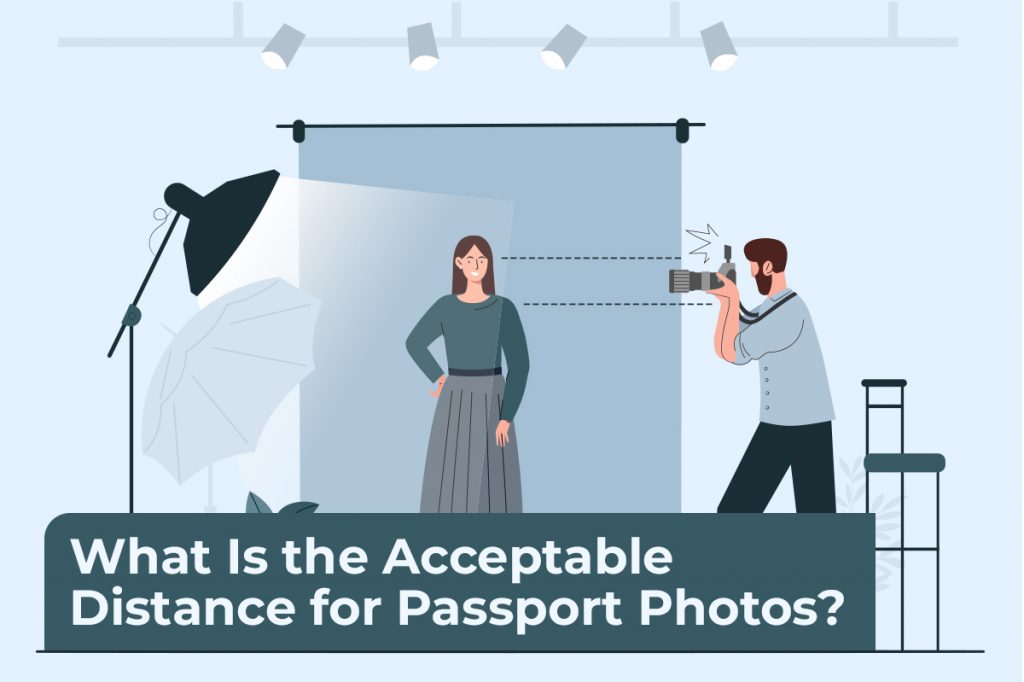Photographs are a vital component of the passport application process, visually representing your identity. Passport photos must adhere to specific guidelines set by the passport issuing authorities to ensure consistency and accuracy. One crucial aspect of passport photos is the distance between the camera and your face or body. This distance, often overlooked but of great significance, plays a pivotal role in capturing a high-quality and compliant passport photo.

What Is the Acceptable Distance for Passport Photos?
The ideal distance between the face and camera in passport photos is typically around 3 to 7 feet (1 to 2 meters). This range ensures proper framing, maintains accurate facial proportions, and reduces potential obstructions, facilitating clear identification. Deviating from this recommended distance may result in distorted or exaggerated facial features, compromising accurate representation.
How Should I Set the Camera for My Passport Photo?
Setting the camera for your passport photo involves considering a few crucial factors:
- Positioning. Place the camera at the recommended distance from you, typically around 3 to 7 feet (1 to 2 meters). This ensures proper framing and allows the entire head and shoulders to be captured within the photo frame.
- Framing. Ensure your face is centered and aligned correctly within the frame. The distance between the camera and the face should form a 90° angle with a line parallel to the back.
- Lighting. Ensure even and well-balanced lighting to avoid harsh shadows or overexposure. Soft, diffused lighting is preferable, and natural or studio lighting setups can be used to achieve this.
- Focus and Sharpness. Set the camera’s focus point on your face to ensure clarity and sharpness. This is crucial for capturing accurate facial details.
- Test Shots. Take a few test shots to review the composition, focus, and overall quality of the photo before capturing the final passport photo. This allows for any necessary adjustments to be made to achieve the desired result.
Why Is the Distance Important in Passport Photos?
The distance in passport photos is important for several reasons:
- Proper Framing and Composition. Maintaining an appropriate distance ensures that the entire head and shoulders of the passport holder are captured within the photo frame. In addition, this framing provides a clear and accurate representation of the individual’s appearance.
- Facial Proportions and Recognition. The distance between the body and the camera affects the perceived proportions of the face. Therefore, the head should be captured naturally and proportionately to ensure accurate identification. This allows facial recognition technology and human officials to compare the photo with the passport holder’s face during verification.
- Eliminating Distortion. When the body is too close to the camera, it can result in distortion or exaggeration of certain facial features, such as the nose or forehead. Maintaining an appropriate distance helps minimize distortion.
- Biometric Data Collection. Some modern passports incorporate additional biometric features beyond facial recognition, such as fingerprints. If required, capturing the body at an appropriate distance allows for consistent and accurate collection of additional biometric data.
- Avoiding Obstruction. Maintaining an appropriate distance helps prevent any unintentional obstruction of the face or features. For example, if the body is too close, hands or objects may block parts of the face, hindering accurate identification.
What Happens if the Distance in My Passport Photo Is Not Within the Acceptable Range?
If the distance in your passport photo does not fall within the acceptable range specified by the passport issuing authority, there can be consequences and potential issues. Here are some possible outcomes:
- Rejection of the Photo. The passport application process typically involves a review of the submitted photo. The authorities may reject the photo, requiring you to provide a new one that adheres to the guidelines.
- Request for Resubmission. Sometimes, the passport issuing authority may request you to resubmit the photo. However, this will further prolong the application process and may require additional time and effort.
- Inconsistent Biometric Data. The biometric data extracted from it may not be reliable or consistent with other official records, potentially causing issues during identity verification.
- Incompliance with International Standards. Your passport photo may not be accepted when traveling internationally or during immigration procedures.
What Are Some Common Mistakes to Avoid When Taking Passport Photos Regarding Distance?
When taking passport photos, it is important to be aware of common mistakes related to the distance between the camera and the face. Avoiding these mistakes can help ensure your passport photo meets the required guidelines. Here are some common errors to avoid:
- Standing Too Close. One common mistake is standing too close to the camera, resulting in a cropped or distorted image. Instead, maintain the recommended distance to capture the entire head and shoulders within the frame.
- Standing Too Far. Conversely, standing too far from the camera can lead to a small or less clear representation of the face. Therefore, it’s essential to maintain an appropriate distance to ensure proper framing and visibility.
- Uneven Distance. In some cases, individuals unintentionally lean forward or backward, resulting in an uneven distance between the camera and the body. This can distort facial features and affect the accuracy of the photo.
- Incorrect Angle. Tilting the head excessively or at an unnatural angle can affect the perception of facial proportions and hinder accurate representation. Instead, keep the head level and straight, facing the camera directly.
